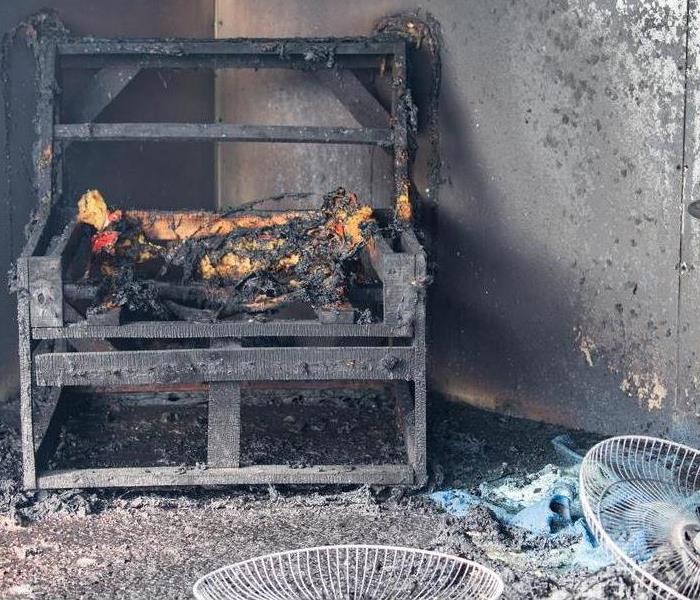How to Deal with Smoke Damage from a Fire
5/30/2019 (Permalink)
 SERVPRO of East Central Austin Professionals are available 24 hours/7 days a week and will respond quickly to a restoration emergency.
SERVPRO of East Central Austin Professionals are available 24 hours/7 days a week and will respond quickly to a restoration emergency.
Fire & Smoke: A Devastating Combination
You've heard the saying, where there's smoke, there's fire. That saying goes both ways, because where there's fire, there's also smoke. If your Austin home or business has experienced a fire, in addition to the fire damage repairs that will inevitably need to be addressed, you'll also need to consider the lingering effects of smoke as well.
Smoke is extremely destructive. Not only will it cause damage to your home, it can also affect your health, particularly your respiratory system.
Smoke contains harmful elements, such as carbon monoxide and high concentrations of carbon dioxide. When you have a fire and subsequent smoke damage, not only will you be breathing in these elements, but smoke residue will also be attaching itself to your home’s walls, floors, clothing, furniture and much more.
Smoke also stinks…literally (and pretty badly), which is why once a fire has occurred, both fire damage restoration and smoke damage restoration will likely be needed. The amount of smoke damage you'll have can vary; the volume of smoke during a fire can be greatly impacted by temperature, ionization and airflow.
Different Types of Smoke and Temperature
There are basically two different types of smoke: wet smoke and dry smoke.
Wet Smoke is often derived from burning materials, such as plastic, rubber and other synthetics. It burns at a low heat, it tends to smolder and leave behind very sticky and messy soot, which is not all that easy to clean on your own.
Dry Smoke tends to burn fast at a very high temperature. The heat from the fire rises, which causes smoke to rise. Hot air always rises during a fire, which is why we’ve always been told to stop, drop and roll when one occurs.
In most cases the temperature of a fire will be directly above the source of the blaze, primarily the ceiling. If cold air is present during a fire, it will decrease beneath any warmer air, which will allow for the smoke to reach exterior walls and windows. It’s not uncommon for smoke to appear on the outside walls, even if the majority of the fire damage repairs will be inside your home.
Smoke after Fire Damage
Smoke has a mysterious way of getting into some of the strangest places that you would least expect, in the aftermath of a fire. Smoke is able to permeate into enclosed spaces, such as drawers, closets and inside your walls. This happens due to warmer air, which attracts molecules, and once a fire is raging, there’s more energy to transfer smoke particles from the fire into the air. With cooler air, there is slower movement, so any particles will have a harder time moving, so they’re more likely to be found in enclosed and hard to reach places.
After a fire, you’re very likely to find more smoke on the backside of drapes, curtains and blinds, as they tend to be cooler places. Drapes can be problematic as the space between the drape and the window is often cooler, so smoke can latch onto the backside and leave abundant traces; the same phenomenon can occur with venetian
blinds as well.
Smoke Particles, Ionization and Airflow
Smoke particles are usually ionized. This means that they carry an electrical charge that gives them the ability to cling to certain surfaces, such as metal nails and screws, plastics and man-made fabrics such as vinyl.
If you have drywall fastened with metal screws, chances are that you’ll find small smoke rings around the screws that have settled on the drywall. If plastic items catch fire, the smoke can create black, stringy shapes that resemble cobwebs (known as ‘smokewebs’) and hang from the wall to the ceiling.
And, of course, most upholstery can become terribly stained from smoke and in many cases you’ll find that whatever has been impacted, is simply not salvageable.
The ducts for your HVAC unit can also become infested with smoke after fire damage has occurred. Even with the unit off, smoke can still seep through the vents and make its way into rooms not even affected by fire.
Removing Smoke
If the fire damage and smoke is extensive, don’t even attempt this on your own. Some smoke damage after a small fire may be manageable on your own, but anything beyond that will need the services of a fire damage restoration professional.
And we can’t stress this enough… always have several smoke detectors in your Austin home, and test the batteries frequently.
SERVPRO of East Central Austin Fire Damage Restoration Services
Since each smoke and fire damage situation varies, it’s important to quickly repair and restore your Austin-based home as quickly as possible.
Fires are devastating, which is why SERVPRO of East Central Austin will go above and beyond to remediate and restore your property after a fire. We’ll evaluate the overall scope of your fire damage repairs and provide the proper equipment and expertise to ensure a smooth restoration process.
We’re a locally owned Austin company, and we care about the community that we serve.
We have the resources to help guide you through this time, and our employees are trained and certified professionals, who have the experience and know-how to handle your fire damage repairs. We’ll utilize our experience and high-tech
equipment to ensure that we clean and deodorize your property thoroughly.
If you’re in need of fire damage restoration, call our local Austin SERVPRO office today: 512-420-9886.



 24/7 Emergency Service
24/7 Emergency Service